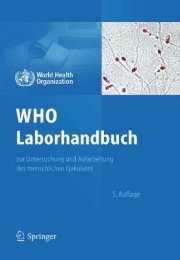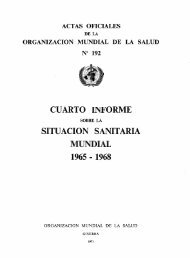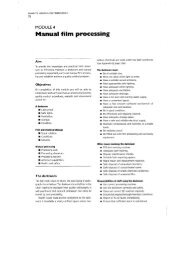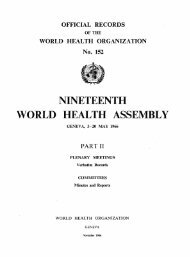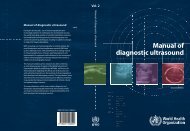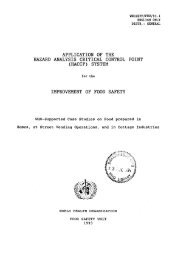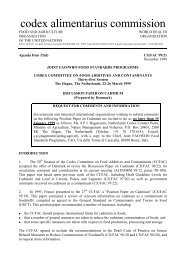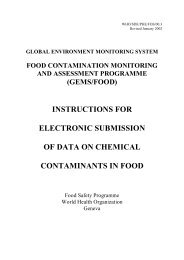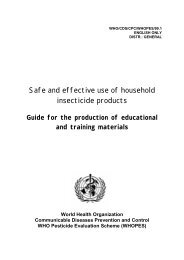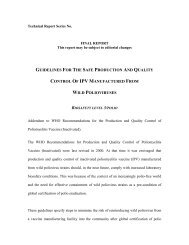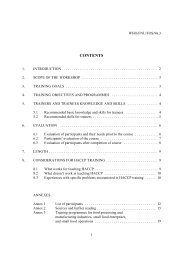WHO Drug Information Vol. 20, No. 4, 2006 - World Health ...
WHO Drug Information Vol. 20, No. 4, 2006 - World Health ...
WHO Drug Information Vol. 20, No. 4, 2006 - World Health ...
Create successful ePaper yourself
Turn your PDF publications into a flip-book with our unique Google optimized e-Paper software.
Safety and Efficacy Issues<br />
contribution of the drug to these events is<br />
not known. Patients with influenza should<br />
be closely monitored for signs of abnormal<br />
behavior throughout the treatment<br />
period. In addition, the following statement<br />
has been added to the patient<br />
information:<br />
People with the flu, particularly children,<br />
may be at an increased risk of self-injury<br />
and confusion shortly after taking oseltamivir<br />
and should be closely monitored<br />
for signs of unusual behavior. A health<br />
care professional should be contacted<br />
immediately if the patient shows<br />
any signs of unusual behavior.<br />
Reference: www.fda.gov/medwatch. Tamiflu®<br />
complete product information at http://<br />
www.rocheusa.com/products/tamiflu/pi.pdf.<br />
Darifenacin hydrobromide<br />
for overactive bladder: what<br />
clinical advantage?<br />
Australia — Darifenacin hydrobromide<br />
(Enablex®) 7.5 mg and 15 mg prolongedrelease<br />
tablets have been approved ifor<br />
overactive bladder.<br />
The contraction of detrusor smooth<br />
muscle involves stimulation of muscarinic<br />
receptors by acetylcholine. Anticholinergic<br />
drugs have therefore been used to relax<br />
the bladder in patients with urge incontinence.<br />
These drugs have unwanted<br />
systemic effects so there is a need for a<br />
drug with an action that is more specific<br />
to the bladder. The M3 muscarinic<br />
receptor has been a target for drug<br />
development as it is thought to be the<br />
subtype responsible for bladder contraction.<br />
Darifenacin is an anticholinergic drug<br />
which has a greater affinity for the M3<br />
receptor than for other subtypes. Its<br />
action diminishes the frequency of detrusor<br />
contractions and increases bladder<br />
capacity.<br />
258<br />
<strong>WHO</strong> <strong>Drug</strong> <strong>Information</strong> <strong>Vol</strong> <strong>20</strong>, <strong>No</strong>. 4, <strong>20</strong>06<br />
Once-daily dosing is possible with the<br />
prolonged-release formulation. Peak<br />
plasma concentrations are reached seven<br />
hours after an oral dose, with a steady<br />
state reached in six days. Bioavailability<br />
depends on the patient’s metabolism.<br />
Darifenacin is extensively metabolised in<br />
the liver and its pharmacokinetics are<br />
affected by moderate hepatic impairment.<br />
As the metabolism involves cytochrome<br />
P450 2D6 and 3A4, there are several<br />
potential drug interactions. The risk of<br />
adverse events may be increased by<br />
CYP2D6 inhibitors such as cimetidine,<br />
fluoxetine and paroxetine. Daily doses of<br />
darifenacin should not exceed 7.5 mg if<br />
the patient is taking an inhibitor of<br />
CYP3A4 such as itraconazole. The<br />
anticholinergic adverse effects of<br />
T T tricyclic antidepressants and drugs for<br />
Parkinson disease may be increased by<br />
darifenacin.<br />
Compared with placebo, patients taking<br />
darifenacin complain more frequently of<br />
dry mouth and constipation. These<br />
adverse effects appear to increase with<br />
the dose. Other adverse effects include<br />
altered vision, dyspepsia and abdominal<br />
pain. Caution is needed if darifenacin is<br />
considered for patients with decreased<br />
gastrointestinal motility or at risk of<br />
urinary retention.<br />
Darifenacin has been studied in people<br />
with overactive bladder. These people<br />
have urinary urgency, but not all of them<br />
have urge incontinence. The benefits of<br />
darifenacin may be less certain in these<br />
patients. Although it achieved statistical<br />
advantages over placebo, the absolute<br />
changes may be small. For example, a<br />
patient given darifenacin 15 mg will have<br />
one less micturition per day than a patient<br />
given a placebo. They may also have one<br />
less episode of urgency per day.<br />
Darifenacin does not decrease the<br />
number of times a patient is awoken by<br />
their overactive bladder significantly more<br />
than placebo (1).



